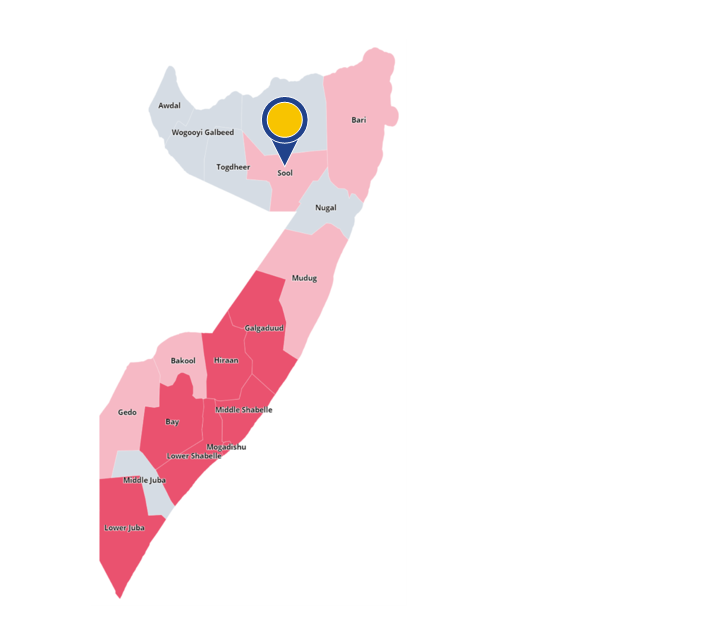COMMON ANALYSIS
Last update: August 2023
The situation in Sool should be seen in light of the situation in the neighbouring regions of Sanaag and Bari.
Main COI references: [Security 2023, 2.7.1., p.167-172; COI Update 2023, 1.1.1., p. 7; 1.3.1., p. 13; 1.3.4., pp. 16-19; 1.3.6., p. 17]

General information
Sool region consists of four districts. Laas Canood is the region’s capital.
Sool is inhabited primarily by Dhulbahante, a Darod / Harti sub-clan, which is part of the Harti confederation together with the Majerteen clans of Puntland. Caynabo town is primarily inhabited by the Isaaq clan.
In 2021, UNOCHA estimated the population of Sool at 464 488 inhabitants.
Background and actors involved in armed confrontations
Puntland and Somaliland dispute over the political and military control of areas in the Sool and Sanaag regions, as well as in the area of Ayn, part of Togdheer region. Sool and Sanaag fall within Somaliland’s boundaries, as per the old Anglo-Italian border and protocol and as put forward by the Somaliland government. Sool local authorities have repeatedly switched sides between Puntland and Somaliland in the past. Old tensions oppose the Dhulbahante clan and Somaliland over long-standing self-determination demands of the clan which declared, in early January 2023, Sool and Sanaag regions as parts of the Federal Republic of Somalia and asked the Somaliland forces to withdraw from the area. [COI Update 2023, 1.1.1., p. 7].
Somaliland forces control the western part of Sool. The capital Laas Canood, Xudun district and Tukaraq are controlled by the Somaliland administration. Boocame, a district previously controlled by Puntland, came under the control of Somaliland forces after May 2022. The areas bordering Nugal and Bari regions are contested by the Somaliland administration and Puntland’s autonomous forces.
In terms of clan rivalries, Sool region is a highly disputed area presenting numerous conflict dynamics. Several inter and intra-clan disputes, involving clan militias, over water wells have been frequently reported. Inter-clan disputes, between Isaaq and Darood clan families have a higher tendency to escalate.
Al-Shabaab presence was not reported in Sool during the reference period.
Nature of violence and examples of incidents
Between February and the beginning of March 2023, twenty-four days of clashes between Somaliland forces and the Dhulbahante clan in Laas Canood left 210 civilians dead, 680 others wounded, and 200 000 families displaced.
Clan militias, unidentified militias or unidentified armed groups were involved in the majority of battles and of incidents of violence against civilians that took place in Sool. Both intra-clan (between Dhulbahante sub-clans) clashes as well as inter-clan clashes between Dhulbahante and Isaaq sub-clans occurred. For example, several clashes between Dhulbahante and Majeerteen clans were reported in Boocame. Furthermore, in January 2022, clashes between tribal militias were reported in the Saahmaygaag and Sanga Jabiye areas of Nugal and Sool regions.
Somaliland police or military forces were involved in a small number of security incidents in the region. For example, on 27 September 2021, a Somaliland police official was killed and another wounded, after Somaliland security forces clashed with an armed group in the town of Xudun. The armed group was reportedly dealing drugs.
An attack on military and police camps of Somaliland forces by a rebel fighters’ group on 15 December 2021 has also been reported.
Incidents: data
ACLED recorded 32 security incidents (an average of 0.4 security incidents per week) in Sool region between 1 July 2021 and 30 November 2022. Out of those incidents, 15 were coded as ‘battles’, 4 as ‘explosions/remote violence’ and 13 as ‘violence against civilians’. In the period from 1 December 2022 to 14 April 2023, 44 security incidents were recorded in Sool representing an average of 2.3 security incidents per week. Out of those incidents, 35 were coded as ‘battles’.
Geographical scope
Security incidents occurred in 2 out of 4 districts of Sool region. All -but one- incidents, took place in Laas Canood district.
Fatalities among civilians and non-civilians
In the 17 months between July 2021 and November 2022, ACLED recorded a total of 55 fatalities in the region. In the 4.5 months between December 2022 and mid-April 2023, ACLED recorded a total of 297 fatalities in the region. Compared to the figures for the population in the region as from 2021, this represents approximately 76 fatalities per 100 000 inhabitants for the whole reference period.
Displacement
Between July 2021 and November 2022, 291 individuals were newly displaced from Sool, according to PRMN. Almost all of them initially resided in the Laas Canood district and were displaced within the same administrative region. The remaining 22 people were displaced either to Wogoyi Galbeed or to Bari regions. In the same period, conflict and insecurity brought in Sool 624 individuals from Bari and Nugal regions.
Between December 2022 and March 2023, 168 544 individuals were newly displaced from Sool, according to PRMN, a region particularly affected by internal displacement due to the incidents in Laas Canood.
Further impact on civilians
Three humanitarian access incidents were documented by UNOCHA between July 2021 and November 2022. It has also been reported that Laas Canood's main hospital has come under attack twice in February 2023.
Looking at the indicators, it can be concluded that indiscriminate violence is taking place in the region of Sool, however not at a high level. Accordingly, a higher level of individual elements is required in order to show substantial grounds for believing that a civilian, returned to the territory, would face a real risk of serious harm within the meaning of Article 15(c) QD.
It can be noted that, at the time of writing, the indiscriminate violence primarily affects the district of Laas Canood and its surroundings.
